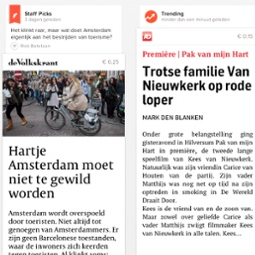Digital technologies have re-shaped the relationship between media outlets and audiences, particularly in the realm of journalism, where an overabundance of free content has trigger a discussion on how to translate the business model for print news to the digital landscape, which in turn had led to the implementation of paywalls and the wide spread of digital advertising.
Now some new services are experimenting with different business models that try to change the way audiences consume news in a new digital experience, in this post I would highlight two different approaches to delivering news in this digital landscape.
The first one is Bendle, a dutch digital kiosk to which it’s founder refer to as the i-tunes of news, the cornerstone of the service it’s the fact that costumers can buy individual articles which cost approximately 20 cents, paying only for the articles they like. In order to bring on board the publishers and news outlets, Bendle focused on creating an experience that would translate the brand identity and experience of the original reading experience, creating a template for each newspaper and magazine, that includes unique font families, sizes, weights and colors, and implementing a reader that scrolls horizontally, in order to imitate the column reading experience on a newspaper.
This strategy has been a huge success on the Netherlands, where the service has over 140000 users and just managed to raise 3 million euro from The New York Times and Axel Springer in order to replicate their services in other european markets.
The second interesting approach has been crowdsourcing, Beacon is a platform that allows writers to connect with their audiences through a crowdsourcing approach, letting readers choose the stories they want to back up. A big twist in the business model is that is not longer relying on the assumption that readers would pay for content, but instead it choose to enhance the connection between writer, story and reader. In this way a reader can back up a specify journalist or a worthy subject by subscribing starting from 5USD per month, and at the same time get access to all the content of the site.
In the same spirit Kickstarter, the biggest crowdfunding platform, last year released a category focused exclusively on journalism, alongside they establish a partnership with The Guardian, to curate and highlight the journalistic projects posted on the site. In contrast with beacon, the kickstarter category on journalism lets writers choose the rewards for the campaign, making for an interesting exchange between writers and their audiences.
I think it’s safe to say that with the ever growing number of technologies that disrupt our assumptions of traditional services, like media, we’re going to start seeing how new business born out of strengthening the relationship between final users and creators, giving the first ones more flexibility in deciding what they want.

